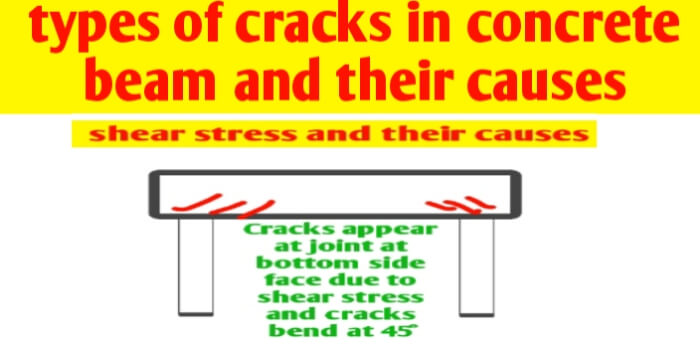Types of cracks in concrete beam and their causes,hi guys in this article we know about types of cracks in concrete beam and their causes. There is several types of cracks occur in concrete beam caused due to shear stress, bending moment, reinforcement corrosion ,insufficient rebar used in concrete ,bending stress and compressive failure.
There is several types of loads acting on column that is shear forces resulting shear stress which is develop maximum at joint of support structure (column) and beam. If Maximum shear stress is more from limiting shear stress of beam that is strength of beam that causes cracks in in lower side face of beam. Let us discuss about several types of cracks in concrete beam and their causes

Different types of cracks in concrete beam
1) shear cracks developed due to shear stress
2) Flexural or tensile cracks developed due to tensile stress
3) combination of shear cracks and flexural cracks due to combination of both shear stress and tensile stress
4) cracks developed due to insufficient use of rebars in concrete beam
5) cracks developed due to corrosion of reinforcement
6) cracks develop compression failure
◆You Can Follow me on Facebook and Subscribe our Youtube Channel
You should also visits:-
1)what is concrete and its types and properties
2) concrete quantity calculation for staircase and its formula
shear cracks developed due to shear stress in concrete beam

Shear forces acting on concrete beam result shear stress which appeared more near the the joint of support structure and beem and wall and column. When amount of shear stress is more than strength of beam that is limiting stress that causes cracks in concrete beam near support of beam at both end.as we know shear stress have little value at mid span of beam so crack have not developed at the mid span of beam L/2 and lateral side of both end L/4 region of beam.
So cracks have developed in concrete beam structure only at region of support of Beem which is appears on side face of beam inclined to 45 degree angle.
Flexural or tensile cracks developed due to tensile stress

When external force is applied on concrete beam structure that is bending moment which causes bending of beem due to development of internal bending stress. We know that there is two types of bending stress is developed one is positive bending moment that is sagging and second one is negative bending moment that is hogging.
In sagging bending moment maximum tension is developed at mid portion of span of beam in bottom side so there is cracks developed in mid span of beem on side face and look like perpendicular to neutral axis in straight line.
In hogging bending moment maximum tension is developed at support region of beem on top side of both end .so there is appearance of cracks on top side of beam near near both end due to hogging bending moment which appears in straight line.
combination of shear cracks and flexural cracks due to combination of both shear stress and tensile stress

There is combination of cracks and musical tracks due to combination of both shear stress and tensile stress appears at L/4 region of span of beam at both top and bottom side face near both end.
Remedy and prevention of shear cracks and tensile cracks
Best prevention of cracks and tensile cracks is in their design of beam structure. When we make the design of beam structure design should have adequate amount of reinforcement used in top layer of beam and bottom layer of beam considering in mind where reinforcement is provided maximum or minimum. Generally in tensile zone of beam we provide higher quantity of reinforcement and in compression zone of beam we provide lesser quantity of reinforcement.
Lower part of mid span and top part of supportive joint of beam at both end have maximum tension so in this areas we provide higher quantity of reinforcement. And upper part of mid span and bottom part of supported joints of beam at both end have compression zone, in this areas we provide the lesser quantity of reinforcement.
Cracks in concrete beam due to Corrosion

Generally beam is provided with slab at the top. top portion of beam is not exposed to environment and their bottom face of beam are exposed to environment and if the concrete cover to reinforcement is insufficient then corrosion of reinforcement takes place so there is cracks developed due to corrosion of reinforcement appear at the bottom of beam at side faces which is running along parallel to beam direction.
Cracks in concrete beam due to insufficient concrete cover

These type of cracks also appear due to corrosion of reinforcement and providing insufficient concrete cover but it appears at the bottom face of beam and these appear parallel to main reinforcement at the bottom.
These type of cracks may be prevent from corrosion by providing adequate amount of concrete cover.
Cracks develop due to compression failure of beam structure
The compressive force acting on beam resulting compressive stress. If maximum compressive stress is developed it will pushes and compressed the beam inward direction that’s couches development of crack in beam structure or beam have buckled or its complete failure of beam. So adequate amount of reinforcement provided at the top face of beam which prevent from developing maximum compressive stress.